Human Resource Management Activities, Team Dynamics Report
VerifiedAdded on 2020/10/22
|20
|5195
|340
Report
AI Summary
This report delves into various aspects of Human Resource Management, covering activities, team dynamics, and project management. Activity 1 focuses on the roles and ethical conduct of HR professionals, referencing the CIPD code of ethics and mapping individual performance based on skills like passion for learning, employee relations, and resourcing. Activity 2 explores team dynamics, including Tuckman's stages of group development and conflict resolution methods using Thomas Kilmann's model and Fisher and Ury's principles. Activity 3 addresses project management, specifically the implementation of a Human Resource Information System (HRIS), detailing initiation, planning, and execution stages with budget considerations. The report provides insights into conflict resolution, project planning, and the importance of continuous learning in HRM.
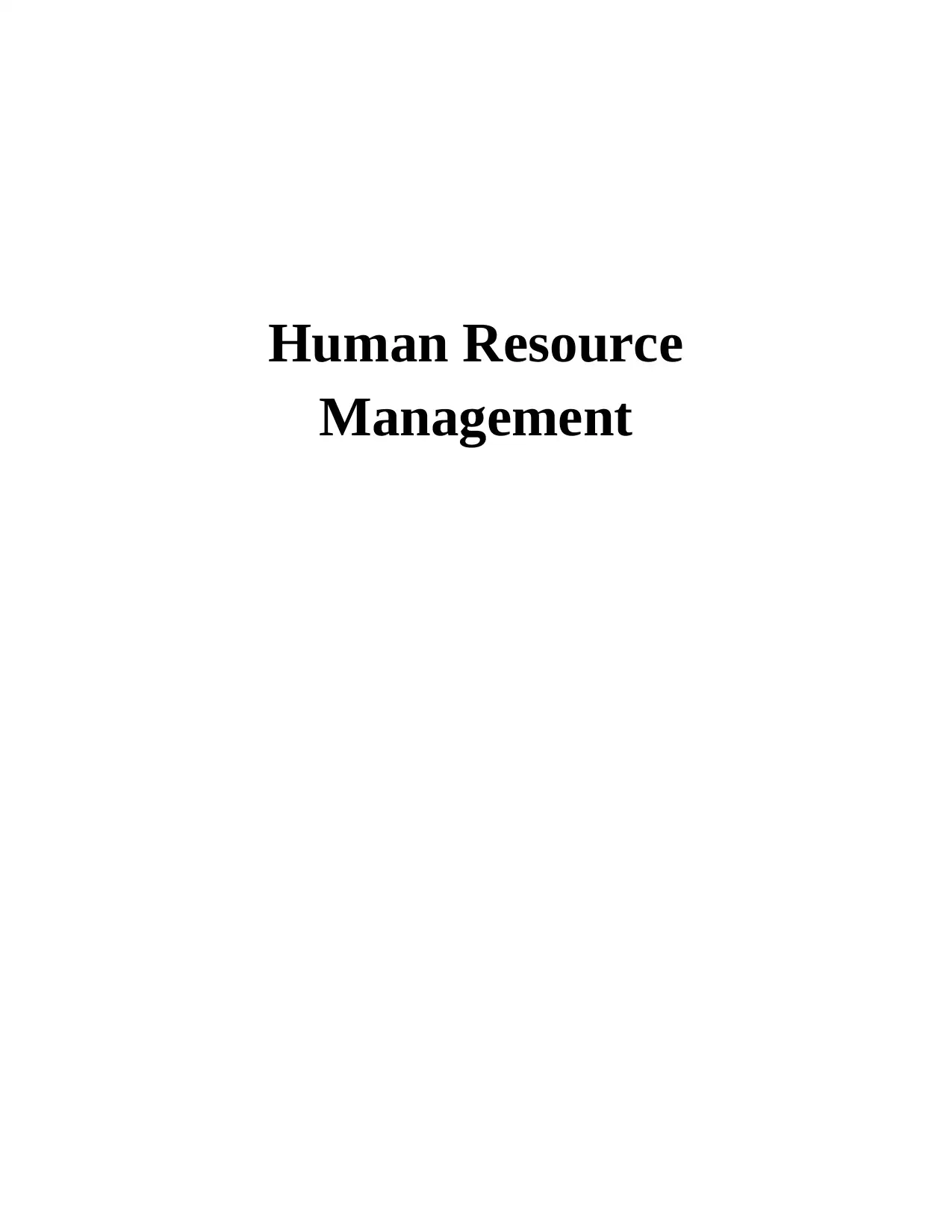
Human Resource
Management
Management
Paraphrase This Document
Need a fresh take? Get an instant paraphrase of this document with our AI Paraphraser
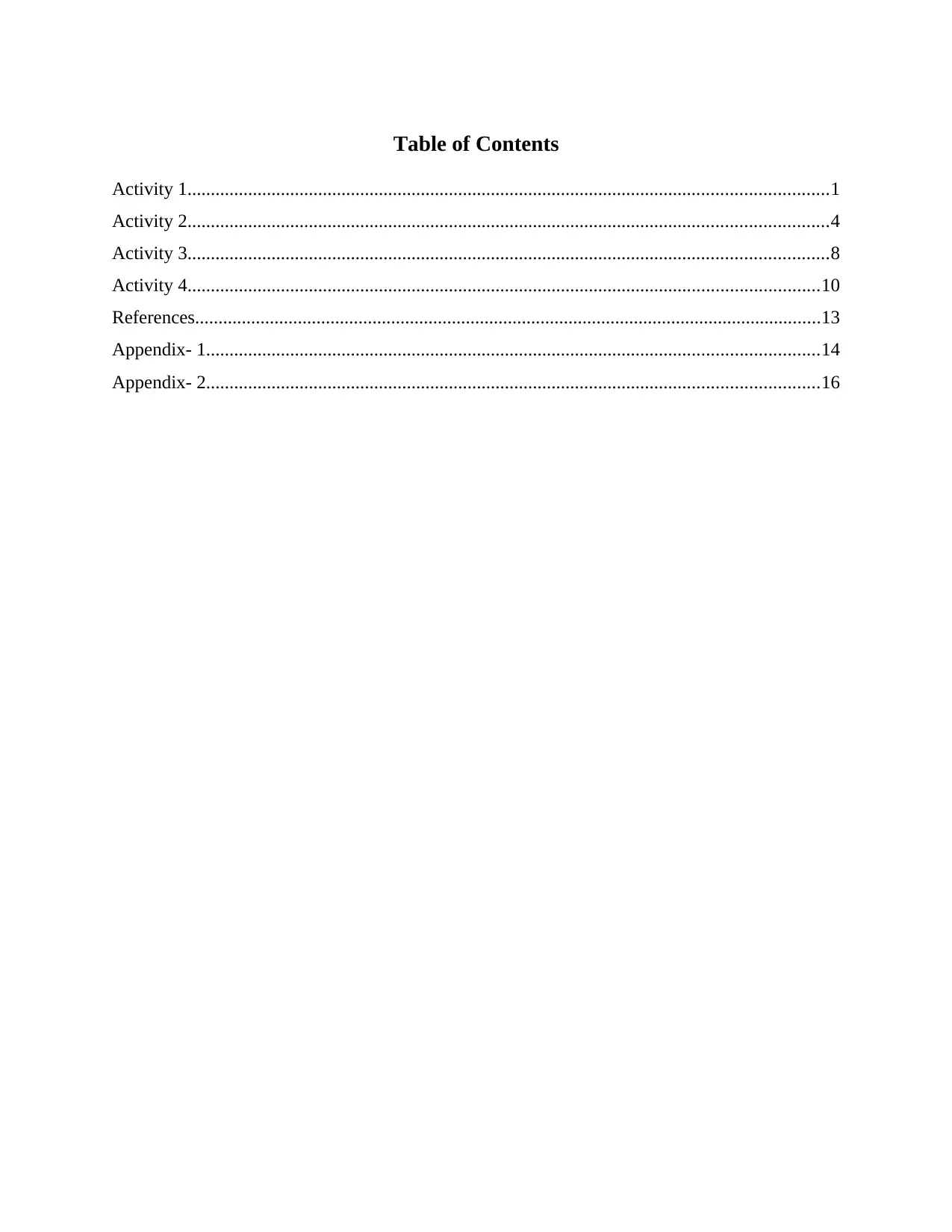
Table of Contents
Activity 1.........................................................................................................................................1
Activity 2.........................................................................................................................................4
Activity 3.........................................................................................................................................8
Activity 4.......................................................................................................................................10
References......................................................................................................................................13
Appendix- 1...................................................................................................................................14
Appendix- 2...................................................................................................................................16
Activity 1.........................................................................................................................................1
Activity 2.........................................................................................................................................4
Activity 3.........................................................................................................................................8
Activity 4.......................................................................................................................................10
References......................................................................................................................................13
Appendix- 1...................................................................................................................................14
Appendix- 2...................................................................................................................................16
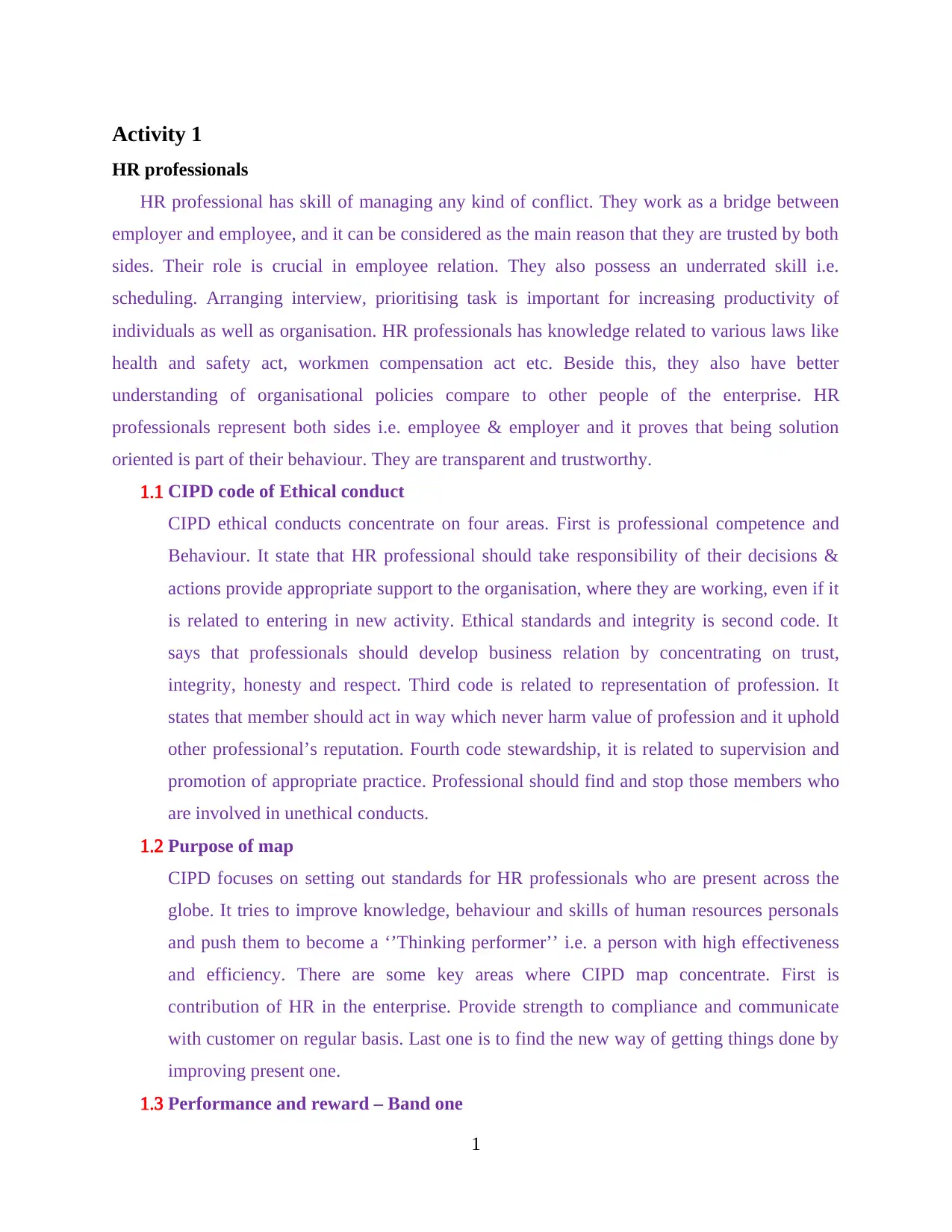
Activity 1
HR professionals
HR professional has skill of managing any kind of conflict. They work as a bridge between
employer and employee, and it can be considered as the main reason that they are trusted by both
sides. Their role is crucial in employee relation. They also possess an underrated skill i.e.
scheduling. Arranging interview, prioritising task is important for increasing productivity of
individuals as well as organisation. HR professionals has knowledge related to various laws like
health and safety act, workmen compensation act etc. Beside this, they also have better
understanding of organisational policies compare to other people of the enterprise. HR
professionals represent both sides i.e. employee & employer and it proves that being solution
oriented is part of their behaviour. They are transparent and trustworthy.
1.1 CIPD code of Ethical conduct
CIPD ethical conducts concentrate on four areas. First is professional competence and
Behaviour. It state that HR professional should take responsibility of their decisions &
actions provide appropriate support to the organisation, where they are working, even if it
is related to entering in new activity. Ethical standards and integrity is second code. It
says that professionals should develop business relation by concentrating on trust,
integrity, honesty and respect. Third code is related to representation of profession. It
states that member should act in way which never harm value of profession and it uphold
other professional’s reputation. Fourth code stewardship, it is related to supervision and
promotion of appropriate practice. Professional should find and stop those members who
are involved in unethical conducts.
1.2 Purpose of map
CIPD focuses on setting out standards for HR professionals who are present across the
globe. It tries to improve knowledge, behaviour and skills of human resources personals
and push them to become a ‘’Thinking performer’’ i.e. a person with high effectiveness
and efficiency. There are some key areas where CIPD map concentrate. First is
contribution of HR in the enterprise. Provide strength to compliance and communicate
with customer on regular basis. Last one is to find the new way of getting things done by
improving present one.
1.3 Performance and reward – Band one
1
HR professionals
HR professional has skill of managing any kind of conflict. They work as a bridge between
employer and employee, and it can be considered as the main reason that they are trusted by both
sides. Their role is crucial in employee relation. They also possess an underrated skill i.e.
scheduling. Arranging interview, prioritising task is important for increasing productivity of
individuals as well as organisation. HR professionals has knowledge related to various laws like
health and safety act, workmen compensation act etc. Beside this, they also have better
understanding of organisational policies compare to other people of the enterprise. HR
professionals represent both sides i.e. employee & employer and it proves that being solution
oriented is part of their behaviour. They are transparent and trustworthy.
1.1 CIPD code of Ethical conduct
CIPD ethical conducts concentrate on four areas. First is professional competence and
Behaviour. It state that HR professional should take responsibility of their decisions &
actions provide appropriate support to the organisation, where they are working, even if it
is related to entering in new activity. Ethical standards and integrity is second code. It
says that professionals should develop business relation by concentrating on trust,
integrity, honesty and respect. Third code is related to representation of profession. It
states that member should act in way which never harm value of profession and it uphold
other professional’s reputation. Fourth code stewardship, it is related to supervision and
promotion of appropriate practice. Professional should find and stop those members who
are involved in unethical conducts.
1.2 Purpose of map
CIPD focuses on setting out standards for HR professionals who are present across the
globe. It tries to improve knowledge, behaviour and skills of human resources personals
and push them to become a ‘’Thinking performer’’ i.e. a person with high effectiveness
and efficiency. There are some key areas where CIPD map concentrate. First is
contribution of HR in the enterprise. Provide strength to compliance and communicate
with customer on regular basis. Last one is to find the new way of getting things done by
improving present one.
1.3 Performance and reward – Band one
1
⊘ This is a preview!⊘
Do you want full access?
Subscribe today to unlock all pages.

Trusted by 1+ million students worldwide
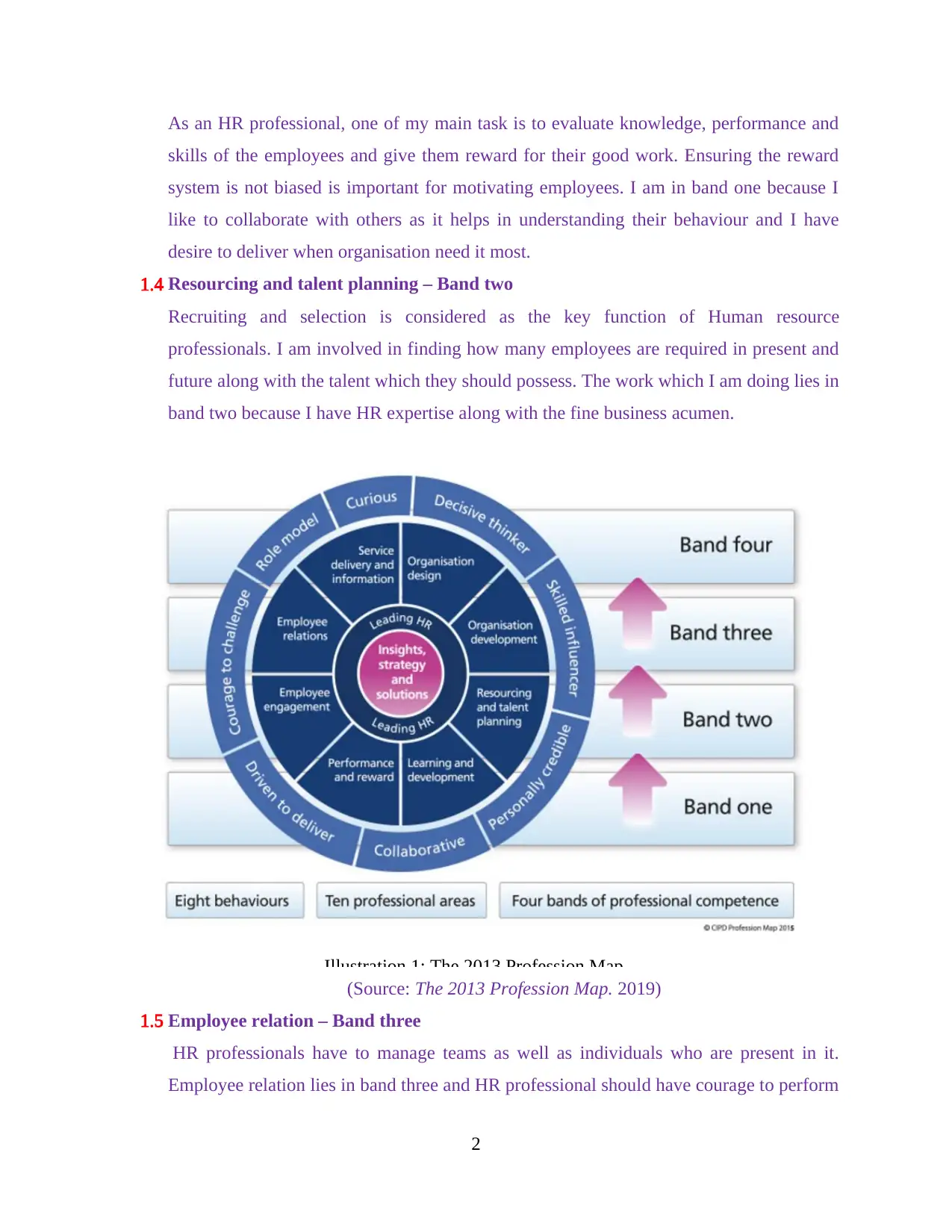
As an HR professional, one of my main task is to evaluate knowledge, performance and
skills of the employees and give them reward for their good work. Ensuring the reward
system is not biased is important for motivating employees. I am in band one because I
like to collaborate with others as it helps in understanding their behaviour and I have
desire to deliver when organisation need it most.
1.4 Resourcing and talent planning – Band two
Recruiting and selection is considered as the key function of Human resource
professionals. I am involved in finding how many employees are required in present and
future along with the talent which they should possess. The work which I am doing lies in
band two because I have HR expertise along with the fine business acumen.
(Source: The 2013 Profession Map. 2019)
1.5 Employee relation – Band three
HR professionals have to manage teams as well as individuals who are present in it.
Employee relation lies in band three and HR professional should have courage to perform
2
Illustration 1: The 2013 Profession Map.
skills of the employees and give them reward for their good work. Ensuring the reward
system is not biased is important for motivating employees. I am in band one because I
like to collaborate with others as it helps in understanding their behaviour and I have
desire to deliver when organisation need it most.
1.4 Resourcing and talent planning – Band two
Recruiting and selection is considered as the key function of Human resource
professionals. I am involved in finding how many employees are required in present and
future along with the talent which they should possess. The work which I am doing lies in
band two because I have HR expertise along with the fine business acumen.
(Source: The 2013 Profession Map. 2019)
1.5 Employee relation – Band three
HR professionals have to manage teams as well as individuals who are present in it.
Employee relation lies in band three and HR professional should have courage to perform
2
Illustration 1: The 2013 Profession Map.
Paraphrase This Document
Need a fresh take? Get an instant paraphrase of this document with our AI Paraphraser
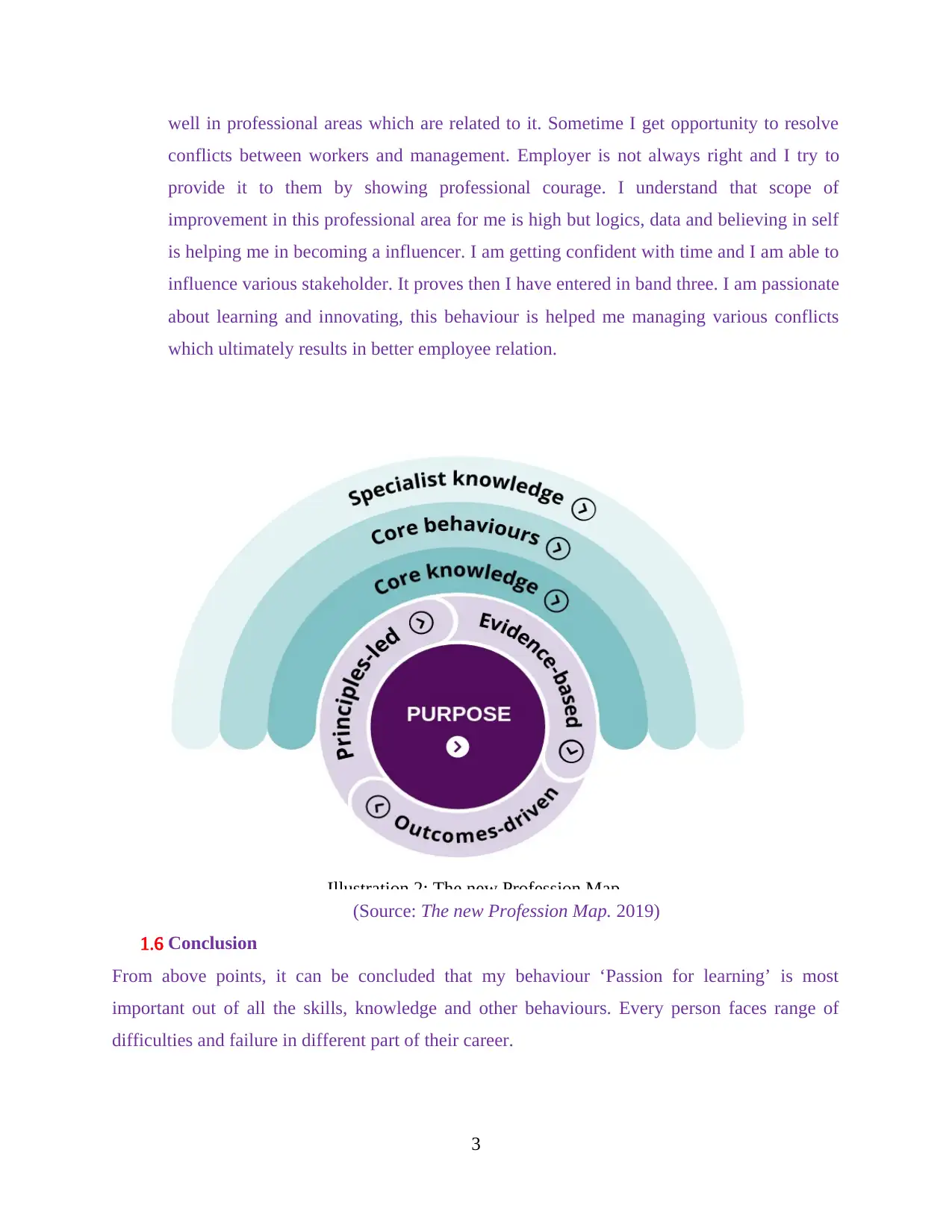
well in professional areas which are related to it. Sometime I get opportunity to resolve
conflicts between workers and management. Employer is not always right and I try to
provide it to them by showing professional courage. I understand that scope of
improvement in this professional area for me is high but logics, data and believing in self
is helping me in becoming a influencer. I am getting confident with time and I am able to
influence various stakeholder. It proves then I have entered in band three. I am passionate
about learning and innovating, this behaviour is helped me managing various conflicts
which ultimately results in better employee relation.
(Source: The new Profession Map. 2019)
1.6 Conclusion
From above points, it can be concluded that my behaviour ‘Passion for learning’ is most
important out of all the skills, knowledge and other behaviours. Every person faces range of
difficulties and failure in different part of their career.
3
Illustration 2: The new Profession Map.
conflicts between workers and management. Employer is not always right and I try to
provide it to them by showing professional courage. I understand that scope of
improvement in this professional area for me is high but logics, data and believing in self
is helping me in becoming a influencer. I am getting confident with time and I am able to
influence various stakeholder. It proves then I have entered in band three. I am passionate
about learning and innovating, this behaviour is helped me managing various conflicts
which ultimately results in better employee relation.
(Source: The new Profession Map. 2019)
1.6 Conclusion
From above points, it can be concluded that my behaviour ‘Passion for learning’ is most
important out of all the skills, knowledge and other behaviours. Every person faces range of
difficulties and failure in different part of their career.
3
Illustration 2: The new Profession Map.
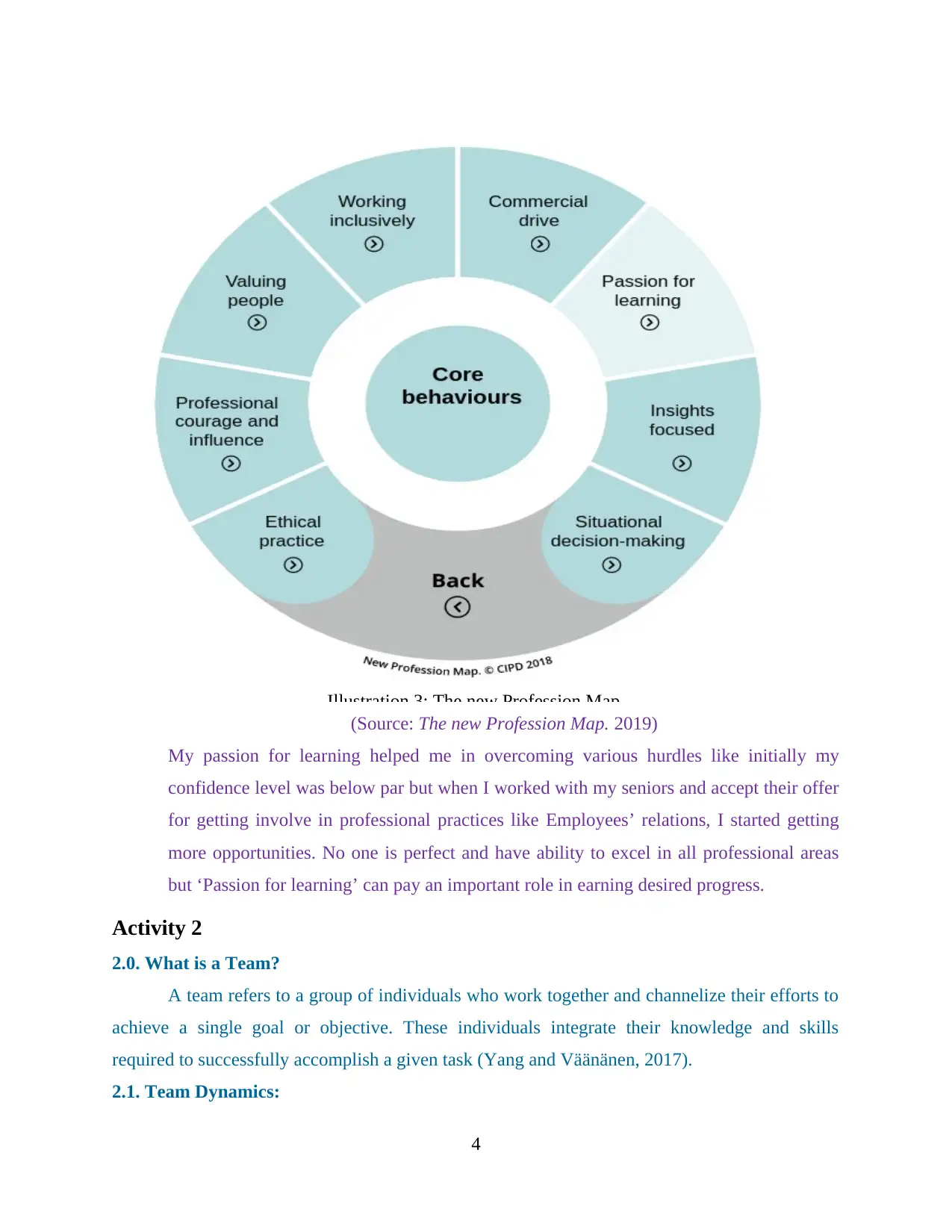
(Source: The new Profession Map. 2019)
My passion for learning helped me in overcoming various hurdles like initially my
confidence level was below par but when I worked with my seniors and accept their offer
for getting involve in professional practices like Employees’ relations, I started getting
more opportunities. No one is perfect and have ability to excel in all professional areas
but ‘Passion for learning’ can pay an important role in earning desired progress.
Activity 2
2.0. What is a Team?
A team refers to a group of individuals who work together and channelize their efforts to
achieve a single goal or objective. These individuals integrate their knowledge and skills
required to successfully accomplish a given task (Yang and Väänänen, 2017).
2.1. Team Dynamics:
4
Illustration 3: The new Profession Map.
My passion for learning helped me in overcoming various hurdles like initially my
confidence level was below par but when I worked with my seniors and accept their offer
for getting involve in professional practices like Employees’ relations, I started getting
more opportunities. No one is perfect and have ability to excel in all professional areas
but ‘Passion for learning’ can pay an important role in earning desired progress.
Activity 2
2.0. What is a Team?
A team refers to a group of individuals who work together and channelize their efforts to
achieve a single goal or objective. These individuals integrate their knowledge and skills
required to successfully accomplish a given task (Yang and Väänänen, 2017).
2.1. Team Dynamics:
4
Illustration 3: The new Profession Map.
⊘ This is a preview!⊘
Do you want full access?
Subscribe today to unlock all pages.

Trusted by 1+ million students worldwide
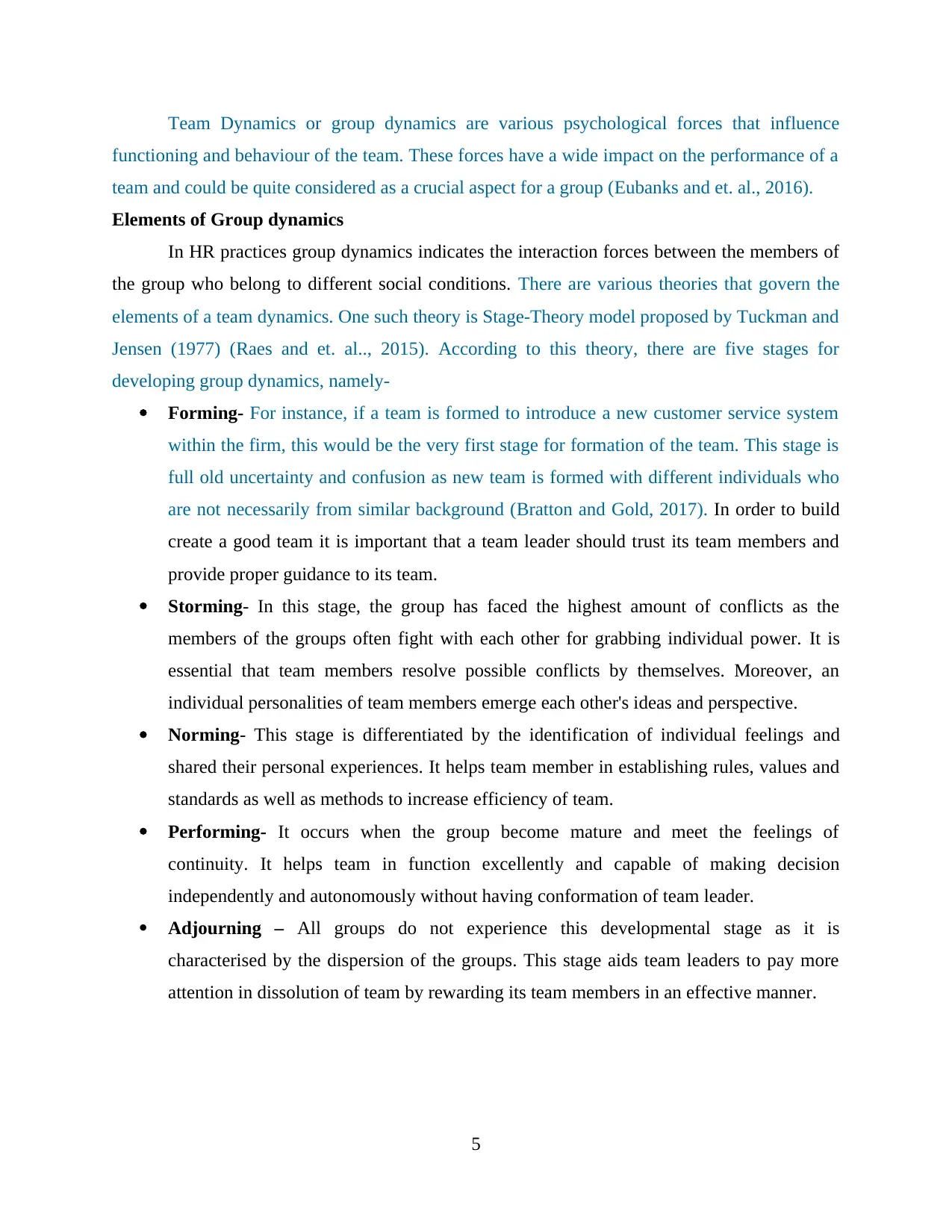
Team Dynamics or group dynamics are various psychological forces that influence
functioning and behaviour of the team. These forces have a wide impact on the performance of a
team and could be quite considered as a crucial aspect for a group (Eubanks and et. al., 2016).
Elements of Group dynamics
In HR practices group dynamics indicates the interaction forces between the members of
the group who belong to different social conditions. There are various theories that govern the
elements of a team dynamics. One such theory is Stage-Theory model proposed by Tuckman and
Jensen (1977) (Raes and et. al.., 2015). According to this theory, there are five stages for
developing group dynamics, namely-
Forming- For instance, if a team is formed to introduce a new customer service system
within the firm, this would be the very first stage for formation of the team. This stage is
full old uncertainty and confusion as new team is formed with different individuals who
are not necessarily from similar background (Bratton and Gold, 2017). In order to build
create a good team it is important that a team leader should trust its team members and
provide proper guidance to its team.
Storming- In this stage, the group has faced the highest amount of conflicts as the
members of the groups often fight with each other for grabbing individual power. It is
essential that team members resolve possible conflicts by themselves. Moreover, an
individual personalities of team members emerge each other's ideas and perspective.
Norming- This stage is differentiated by the identification of individual feelings and
shared their personal experiences. It helps team member in establishing rules, values and
standards as well as methods to increase efficiency of team.
Performing- It occurs when the group become mature and meet the feelings of
continuity. It helps team in function excellently and capable of making decision
independently and autonomously without having conformation of team leader.
Adjourning – All groups do not experience this developmental stage as it is
characterised by the dispersion of the groups. This stage aids team leaders to pay more
attention in dissolution of team by rewarding its team members in an effective manner.
5
functioning and behaviour of the team. These forces have a wide impact on the performance of a
team and could be quite considered as a crucial aspect for a group (Eubanks and et. al., 2016).
Elements of Group dynamics
In HR practices group dynamics indicates the interaction forces between the members of
the group who belong to different social conditions. There are various theories that govern the
elements of a team dynamics. One such theory is Stage-Theory model proposed by Tuckman and
Jensen (1977) (Raes and et. al.., 2015). According to this theory, there are five stages for
developing group dynamics, namely-
Forming- For instance, if a team is formed to introduce a new customer service system
within the firm, this would be the very first stage for formation of the team. This stage is
full old uncertainty and confusion as new team is formed with different individuals who
are not necessarily from similar background (Bratton and Gold, 2017). In order to build
create a good team it is important that a team leader should trust its team members and
provide proper guidance to its team.
Storming- In this stage, the group has faced the highest amount of conflicts as the
members of the groups often fight with each other for grabbing individual power. It is
essential that team members resolve possible conflicts by themselves. Moreover, an
individual personalities of team members emerge each other's ideas and perspective.
Norming- This stage is differentiated by the identification of individual feelings and
shared their personal experiences. It helps team member in establishing rules, values and
standards as well as methods to increase efficiency of team.
Performing- It occurs when the group become mature and meet the feelings of
continuity. It helps team in function excellently and capable of making decision
independently and autonomously without having conformation of team leader.
Adjourning – All groups do not experience this developmental stage as it is
characterised by the dispersion of the groups. This stage aids team leaders to pay more
attention in dissolution of team by rewarding its team members in an effective manner.
5
Paraphrase This Document
Need a fresh take? Get an instant paraphrase of this document with our AI Paraphraser
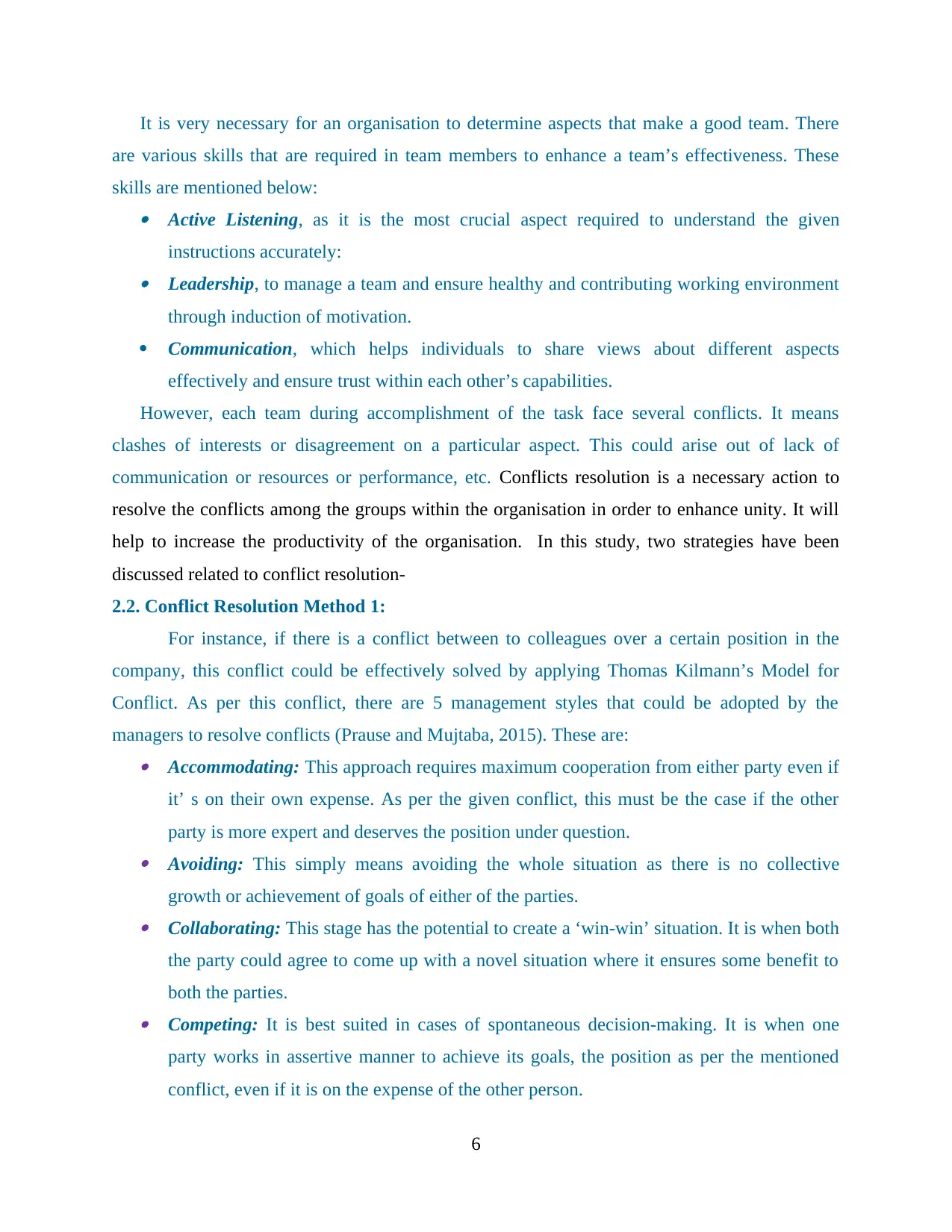
It is very necessary for an organisation to determine aspects that make a good team. There
are various skills that are required in team members to enhance a team’s effectiveness. These
skills are mentioned below: Active Listening, as it is the most crucial aspect required to understand the given
instructions accurately: Leadership, to manage a team and ensure healthy and contributing working environment
through induction of motivation.
Communication, which helps individuals to share views about different aspects
effectively and ensure trust within each other’s capabilities.
However, each team during accomplishment of the task face several conflicts. It means
clashes of interests or disagreement on a particular aspect. This could arise out of lack of
communication or resources or performance, etc. Conflicts resolution is a necessary action to
resolve the conflicts among the groups within the organisation in order to enhance unity. It will
help to increase the productivity of the organisation. In this study, two strategies have been
discussed related to conflict resolution-
2.2. Conflict Resolution Method 1:
For instance, if there is a conflict between to colleagues over a certain position in the
company, this conflict could be effectively solved by applying Thomas Kilmann’s Model for
Conflict. As per this conflict, there are 5 management styles that could be adopted by the
managers to resolve conflicts (Prause and Mujtaba, 2015). These are: Accommodating: This approach requires maximum cooperation from either party even if
it’ s on their own expense. As per the given conflict, this must be the case if the other
party is more expert and deserves the position under question. Avoiding: This simply means avoiding the whole situation as there is no collective
growth or achievement of goals of either of the parties. Collaborating: This stage has the potential to create a ‘win-win’ situation. It is when both
the party could agree to come up with a novel situation where it ensures some benefit to
both the parties. Competing: It is best suited in cases of spontaneous decision-making. It is when one
party works in assertive manner to achieve its goals, the position as per the mentioned
conflict, even if it is on the expense of the other person.
6
are various skills that are required in team members to enhance a team’s effectiveness. These
skills are mentioned below: Active Listening, as it is the most crucial aspect required to understand the given
instructions accurately: Leadership, to manage a team and ensure healthy and contributing working environment
through induction of motivation.
Communication, which helps individuals to share views about different aspects
effectively and ensure trust within each other’s capabilities.
However, each team during accomplishment of the task face several conflicts. It means
clashes of interests or disagreement on a particular aspect. This could arise out of lack of
communication or resources or performance, etc. Conflicts resolution is a necessary action to
resolve the conflicts among the groups within the organisation in order to enhance unity. It will
help to increase the productivity of the organisation. In this study, two strategies have been
discussed related to conflict resolution-
2.2. Conflict Resolution Method 1:
For instance, if there is a conflict between to colleagues over a certain position in the
company, this conflict could be effectively solved by applying Thomas Kilmann’s Model for
Conflict. As per this conflict, there are 5 management styles that could be adopted by the
managers to resolve conflicts (Prause and Mujtaba, 2015). These are: Accommodating: This approach requires maximum cooperation from either party even if
it’ s on their own expense. As per the given conflict, this must be the case if the other
party is more expert and deserves the position under question. Avoiding: This simply means avoiding the whole situation as there is no collective
growth or achievement of goals of either of the parties. Collaborating: This stage has the potential to create a ‘win-win’ situation. It is when both
the party could agree to come up with a novel situation where it ensures some benefit to
both the parties. Competing: It is best suited in cases of spontaneous decision-making. It is when one
party works in assertive manner to achieve its goals, the position as per the mentioned
conflict, even if it is on the expense of the other person.
6
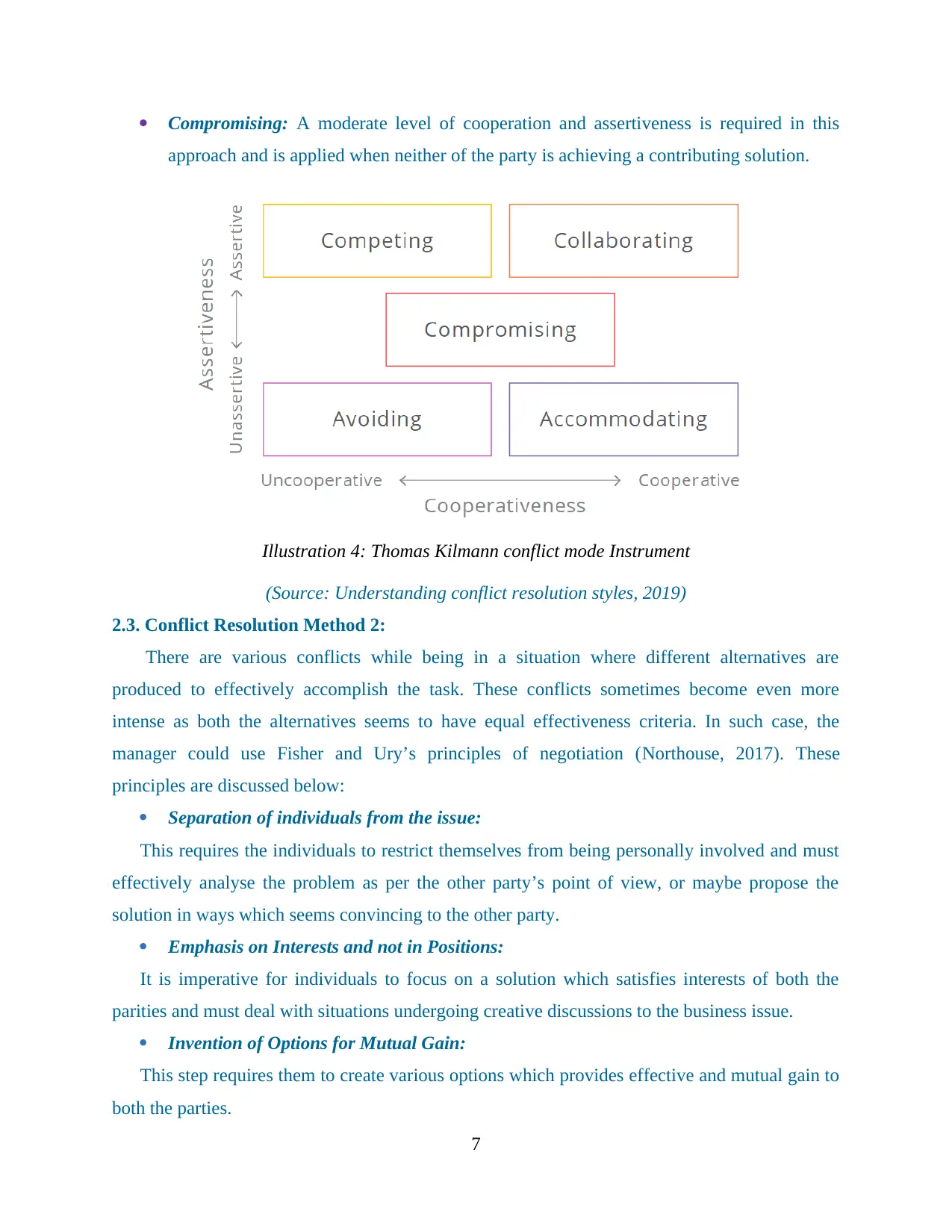
Compromising: A moderate level of cooperation and assertiveness is required in this
approach and is applied when neither of the party is achieving a contributing solution.
Illustration 4: Thomas Kilmann conflict mode Instrument
(Source: Understanding conflict resolution styles, 2019)
2.3. Conflict Resolution Method 2:
There are various conflicts while being in a situation where different alternatives are
produced to effectively accomplish the task. These conflicts sometimes become even more
intense as both the alternatives seems to have equal effectiveness criteria. In such case, the
manager could use Fisher and Ury’s principles of negotiation (Northouse, 2017). These
principles are discussed below:
Separation of individuals from the issue:
This requires the individuals to restrict themselves from being personally involved and must
effectively analyse the problem as per the other party’s point of view, or maybe propose the
solution in ways which seems convincing to the other party.
Emphasis on Interests and not in Positions:
It is imperative for individuals to focus on a solution which satisfies interests of both the
parities and must deal with situations undergoing creative discussions to the business issue.
Invention of Options for Mutual Gain:
This step requires them to create various options which provides effective and mutual gain to
both the parties.
7
approach and is applied when neither of the party is achieving a contributing solution.
Illustration 4: Thomas Kilmann conflict mode Instrument
(Source: Understanding conflict resolution styles, 2019)
2.3. Conflict Resolution Method 2:
There are various conflicts while being in a situation where different alternatives are
produced to effectively accomplish the task. These conflicts sometimes become even more
intense as both the alternatives seems to have equal effectiveness criteria. In such case, the
manager could use Fisher and Ury’s principles of negotiation (Northouse, 2017). These
principles are discussed below:
Separation of individuals from the issue:
This requires the individuals to restrict themselves from being personally involved and must
effectively analyse the problem as per the other party’s point of view, or maybe propose the
solution in ways which seems convincing to the other party.
Emphasis on Interests and not in Positions:
It is imperative for individuals to focus on a solution which satisfies interests of both the
parities and must deal with situations undergoing creative discussions to the business issue.
Invention of Options for Mutual Gain:
This step requires them to create various options which provides effective and mutual gain to
both the parties.
7
⊘ This is a preview!⊘
Do you want full access?
Subscribe today to unlock all pages.

Trusted by 1+ million students worldwide
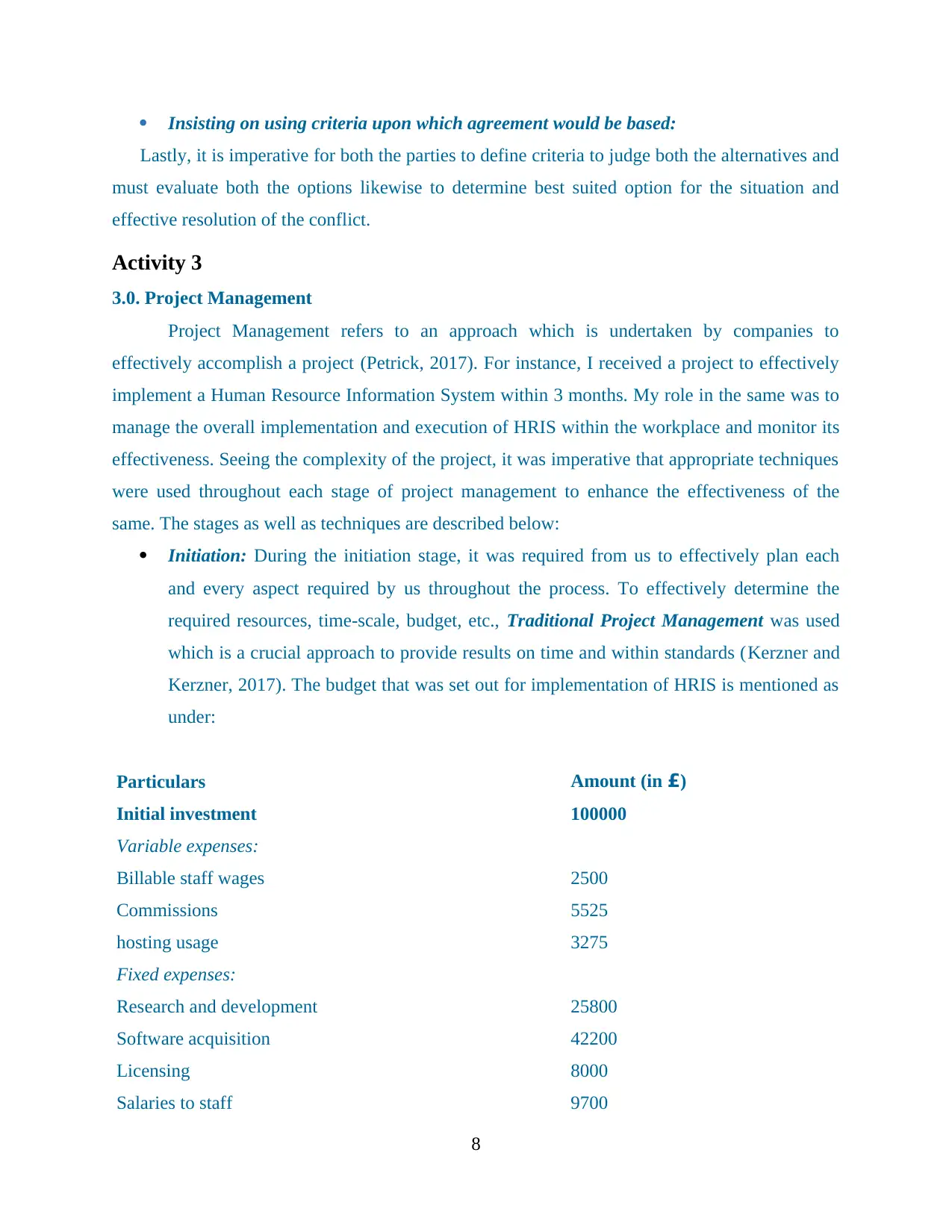
Insisting on using criteria upon which agreement would be based:
Lastly, it is imperative for both the parties to define criteria to judge both the alternatives and
must evaluate both the options likewise to determine best suited option for the situation and
effective resolution of the conflict.
Activity 3
3.0. Project Management
Project Management refers to an approach which is undertaken by companies to
effectively accomplish a project (Petrick, 2017). For instance, I received a project to effectively
implement a Human Resource Information System within 3 months. My role in the same was to
manage the overall implementation and execution of HRIS within the workplace and monitor its
effectiveness. Seeing the complexity of the project, it was imperative that appropriate techniques
were used throughout each stage of project management to enhance the effectiveness of the
same. The stages as well as techniques are described below:
Initiation: During the initiation stage, it was required from us to effectively plan each
and every aspect required by us throughout the process. To effectively determine the
required resources, time-scale, budget, etc., Traditional Project Management was used
which is a crucial approach to provide results on time and within standards (Kerzner and
Kerzner, 2017). The budget that was set out for implementation of HRIS is mentioned as
under:
Particulars Amount (in £)
Initial investment 100000
Variable expenses:
Billable staff wages 2500
Commissions 5525
hosting usage 3275
Fixed expenses:
Research and development 25800
Software acquisition 42200
Licensing 8000
Salaries to staff 9700
8
Lastly, it is imperative for both the parties to define criteria to judge both the alternatives and
must evaluate both the options likewise to determine best suited option for the situation and
effective resolution of the conflict.
Activity 3
3.0. Project Management
Project Management refers to an approach which is undertaken by companies to
effectively accomplish a project (Petrick, 2017). For instance, I received a project to effectively
implement a Human Resource Information System within 3 months. My role in the same was to
manage the overall implementation and execution of HRIS within the workplace and monitor its
effectiveness. Seeing the complexity of the project, it was imperative that appropriate techniques
were used throughout each stage of project management to enhance the effectiveness of the
same. The stages as well as techniques are described below:
Initiation: During the initiation stage, it was required from us to effectively plan each
and every aspect required by us throughout the process. To effectively determine the
required resources, time-scale, budget, etc., Traditional Project Management was used
which is a crucial approach to provide results on time and within standards (Kerzner and
Kerzner, 2017). The budget that was set out for implementation of HRIS is mentioned as
under:
Particulars Amount (in £)
Initial investment 100000
Variable expenses:
Billable staff wages 2500
Commissions 5525
hosting usage 3275
Fixed expenses:
Research and development 25800
Software acquisition 42200
Licensing 8000
Salaries to staff 9700
8
Paraphrase This Document
Need a fresh take? Get an instant paraphrase of this document with our AI Paraphraser
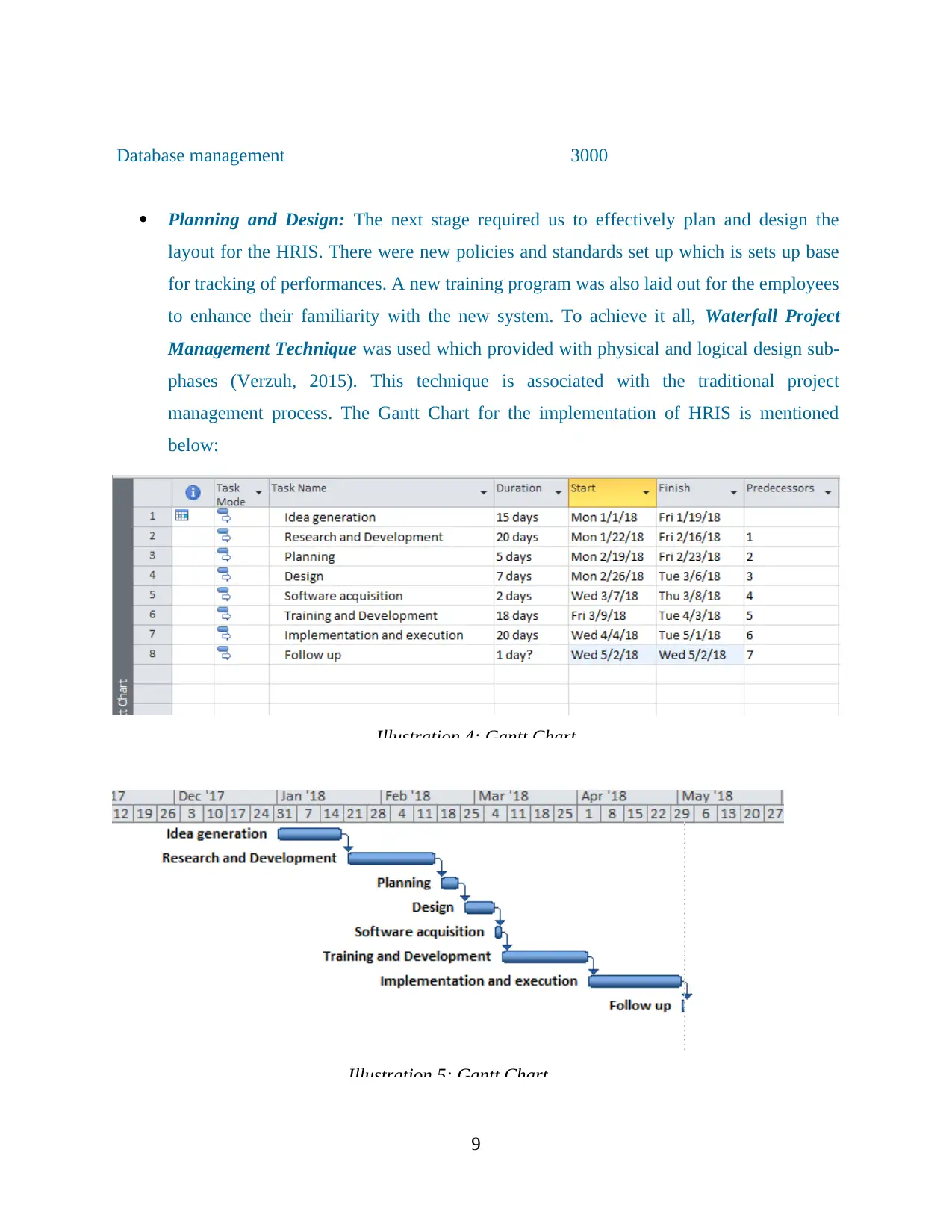
Database management 3000
Planning and Design: The next stage required us to effectively plan and design the
layout for the HRIS. There were new policies and standards set up which is sets up base
for tracking of performances. A new training program was also laid out for the employees
to enhance their familiarity with the new system. To achieve it all, Waterfall Project
Management Technique was used which provided with physical and logical design sub-
phases (Verzuh, 2015). This technique is associated with the traditional project
management process. The Gantt Chart for the implementation of HRIS is mentioned
below:
Illustration 4: Gantt Chart
Illustration 5: Gantt Chart
9
Planning and Design: The next stage required us to effectively plan and design the
layout for the HRIS. There were new policies and standards set up which is sets up base
for tracking of performances. A new training program was also laid out for the employees
to enhance their familiarity with the new system. To achieve it all, Waterfall Project
Management Technique was used which provided with physical and logical design sub-
phases (Verzuh, 2015). This technique is associated with the traditional project
management process. The Gantt Chart for the implementation of HRIS is mentioned
below:
Illustration 4: Gantt Chart
Illustration 5: Gantt Chart
9
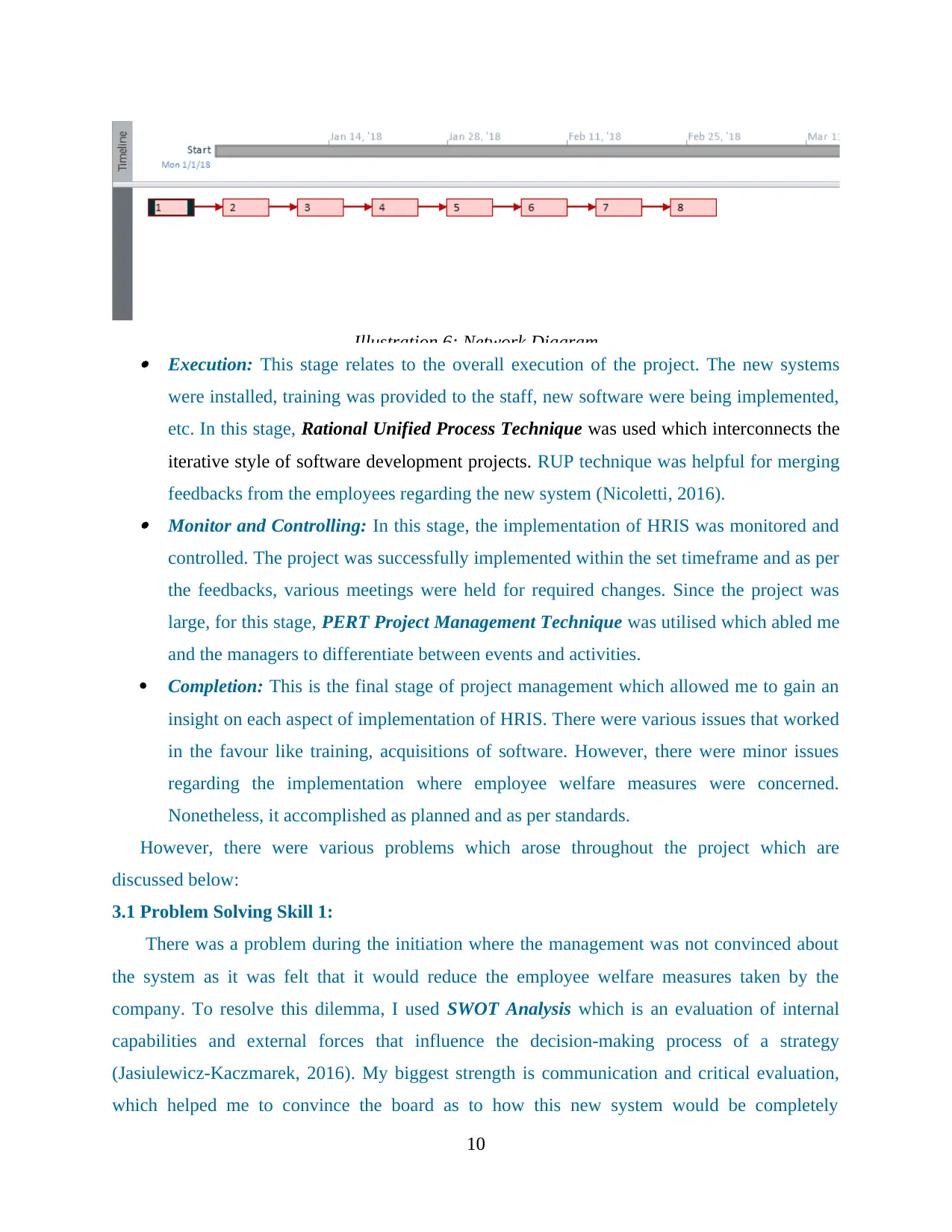
Illustration 6: Network Diagram
Execution: This stage relates to the overall execution of the project. The new systems
were installed, training was provided to the staff, new software were being implemented,
etc. In this stage, Rational Unified Process Technique was used which interconnects the
iterative style of software development projects. RUP technique was helpful for merging
feedbacks from the employees regarding the new system (Nicoletti, 2016). Monitor and Controlling: In this stage, the implementation of HRIS was monitored and
controlled. The project was successfully implemented within the set timeframe and as per
the feedbacks, various meetings were held for required changes. Since the project was
large, for this stage, PERT Project Management Technique was utilised which abled me
and the managers to differentiate between events and activities.
Completion: This is the final stage of project management which allowed me to gain an
insight on each aspect of implementation of HRIS. There were various issues that worked
in the favour like training, acquisitions of software. However, there were minor issues
regarding the implementation where employee welfare measures were concerned.
Nonetheless, it accomplished as planned and as per standards.
However, there were various problems which arose throughout the project which are
discussed below:
3.1 Problem Solving Skill 1:
There was a problem during the initiation where the management was not convinced about
the system as it was felt that it would reduce the employee welfare measures taken by the
company. To resolve this dilemma, I used SWOT Analysis which is an evaluation of internal
capabilities and external forces that influence the decision-making process of a strategy
(Jasiulewicz-Kaczmarek, 2016). My biggest strength is communication and critical evaluation,
which helped me to convince the board as to how this new system would be completely
10
Execution: This stage relates to the overall execution of the project. The new systems
were installed, training was provided to the staff, new software were being implemented,
etc. In this stage, Rational Unified Process Technique was used which interconnects the
iterative style of software development projects. RUP technique was helpful for merging
feedbacks from the employees regarding the new system (Nicoletti, 2016). Monitor and Controlling: In this stage, the implementation of HRIS was monitored and
controlled. The project was successfully implemented within the set timeframe and as per
the feedbacks, various meetings were held for required changes. Since the project was
large, for this stage, PERT Project Management Technique was utilised which abled me
and the managers to differentiate between events and activities.
Completion: This is the final stage of project management which allowed me to gain an
insight on each aspect of implementation of HRIS. There were various issues that worked
in the favour like training, acquisitions of software. However, there were minor issues
regarding the implementation where employee welfare measures were concerned.
Nonetheless, it accomplished as planned and as per standards.
However, there were various problems which arose throughout the project which are
discussed below:
3.1 Problem Solving Skill 1:
There was a problem during the initiation where the management was not convinced about
the system as it was felt that it would reduce the employee welfare measures taken by the
company. To resolve this dilemma, I used SWOT Analysis which is an evaluation of internal
capabilities and external forces that influence the decision-making process of a strategy
(Jasiulewicz-Kaczmarek, 2016). My biggest strength is communication and critical evaluation,
which helped me to convince the board as to how this new system would be completely
10
⊘ This is a preview!⊘
Do you want full access?
Subscribe today to unlock all pages.

Trusted by 1+ million students worldwide
1 out of 20
Related Documents
Your All-in-One AI-Powered Toolkit for Academic Success.
+13062052269
info@desklib.com
Available 24*7 on WhatsApp / Email
![[object Object]](/_next/static/media/star-bottom.7253800d.svg)
Unlock your academic potential
Copyright © 2020–2025 A2Z Services. All Rights Reserved. Developed and managed by ZUCOL.

![5DVP: Developing Professional Practice Report - [University Name]](/_next/image/?url=https%3A%2F%2Fdesklib.com%2Fmedia%2Fimages%2Frq%2Fd1f1fed29d4c4b72b622be5f5f3b52cf.jpg&w=256&q=75)


